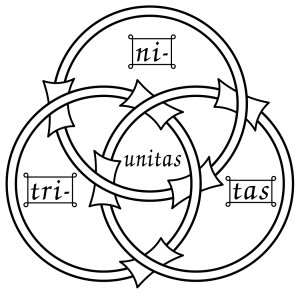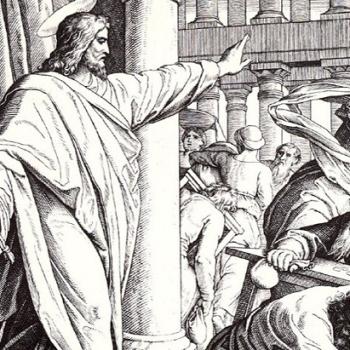
In pondering the Trinity and gender relationships, I am reminded – as important and unique as this doctrine is to Christianity – how remarkable it is that the Trinity per se is never mentioned in the Bible. Evidently, neither Biblical authors, nor Jesus, felt the need to define it as such; yet, the concept of the Trinity is articulated clearly enough in the Bible that it is identified, if also unnamed, in our creeds.
Of course, the Trinity is a holy mystery that not even millennia of Christian scholarship can explain satisfactorily. Artists throughout the ages have attempted to render the Trinity in various ways, and their visual interpretations are worth considering as well; as the saying goes, a picture is worth a thousand words.
In this post I will explore the potential parallels between the inner relational dynamics of the Trinity and gender relationships through an examination of credal doctrine, relevant Biblical texts, and a representation of the Trinity in a medieval French manuscript.
The Trinity in the Nicene creed
In the Nicene creed, we confess the following: “I believe in one God, the Father Almighty, maker of heaven and earth…And in one Lord Jesus Christ, the only-begotten Son of God, begotten of his Father before all worlds, God of God, Light of Light, very God of very God, begotten, not made, being of one substance with the Father; by whom all things were made…and [who] sits on the right hand of the Father…And I believe in the Holy Ghost, the Lord, and Giver of Life, who proceeds from the Father and the Son; who with the Father and the Son together is worshiped and glorified; who has spoken through the Prophets.”
The relationship of the persons of the Trinity, as outlined above, has been traditionally expressed in terms of two doctrines:
- The doctrine of eternal generation, which describes the Son’s relationship to the Father. Although “begotten of” his Father, the Son exists eternally with him and is not “created” as such. Creation implies a beginning, and there is no beginning for the Son – just as there is no beginning for the Father. They are “of one substance”: “God from God, Light from Light, very God of very God.”
- The doctrine of eternal procession, which describes the Holy Spirit’s relationship with the Father and the Son as “proceeding” from them and “worshipped and glorified” together with them. Jesus articulates the concept of eternal procession in John 15:26: “When the Advocate comes, whom I will send to you from the Father, the Spirit of truth who comes from the Father, he will testify on my behalf.”
The Trinity in art: the Borromean rings
The illustration for this post, taken from a 13th century French manuscript, provides a tangible metaphor for understanding the “one substance” of the Trinity and the equality of its persons. Each ring, equal in size and representing a person of the Trinity, is overlayed proportionately atop the other, but not exactly overlayed, so that three distinct rings (or persons) can still be distinguished. This graphic captures the tension of unity in trinity that the doctrine of the Trinity invites us to embrace.
The Trinity and gender dynamics: bearing the image of a triune God
Since human beings are created in the image of God – and God himself is triune in nature – it makes sense that trinitarian relational dynamics might be somehow enfolded into human relationships. It’s important to note, as Keith Johnson does here, that we have to be careful inferring human relational dynamics from those of the Trinity. In discussing Augustine’s analysis of the matter, Johnson writes that nothing created can sufficiently mirror God’s immanent and sinless nature. Moreover, Johnson notes that using the Trinity as a “blueprint” for human relationships is a modern theological trend that is not reflected in the New Testament.
But what if God intended human relationships to reflect his own internal relational paradigm?
By creating humans as male and female – two gendered persons of the same fundamental substance – who come together to create third person, a child, God recapitulates, as it were, his own ontology – a community of persons. This community of persons generates over and over again, in abundance, until there are tribes, states, civilizations. Ideally, humanity prospers. The structure of the Trinity, its abundance, and its life-giving nature are thus imparted to humanity through gender and the sexual reproduction that ensues from sexually differentiated, gendered bodies. While one does not have to reproduce sexually to build community, procreation, as ordained by God, is foundational for human flourishing, as I discuss further in a previous post.
In Faithful: A Theology of Sex, Beth Felker Jones posits that sex is so important to God because it is one of the most powerful icons of his self-giving love, which we see at work in the persons of the Trinity. In her view, man and woman, through sexual love, uniquely bear God’s image.
The Trinity and gender hierarchies
Can we also infer gender hierarchies (or their absence) from the Trinity?
In the Nicene creed, the co-equality of the persons of the Trinity is described in the following way: “God from God, Light from Light, very God from very God.” Similar language is used by Adam to describe Eve in Gen. 2:23, when he sees her for the first time: “This one at last is bone of my bones and flesh of my flesh!” Like the persons of the Trinity, men and women are co-equals, of the same substance. Even if, as Johnson argues, the New Testament is silent on human relational parallels to the Trinity, the striking parallel to Genesis in the creed’s description of God’s persons establishes a solid basis for using the Trinity – at least to a certain extent – as a schema for gender relationships.
In recent decades, advocates of complementarianism have attempted to reformulate the doctrine of the Trinity in ways that support a gender hierarchy. (Apparently, one must reformulate the doctrine of the Trinity to support complementarianism, because the doctrine – as traditionally interpreted by the church – doesn’t do that.)
These efforts to redefine the Trinity potentially cross over into heresy by ultimately denying the credal (and Biblical) co-equality God’s Persons, through the following concepts:
- Eternal Subordination of the Son (ESS);
- Eternal Functional Subordination of the Son (EFS);
- and Eternal Relations of Authority and Submission (ERAS), a follow-on to ESS and EFS
While I am grossly simplifying ESS/EFS/ERAS for the sake of expediency, the argument is essentially that the Father, Son, and Holy Spirit are ontologically equal, but the Son remains eternally, functionally subordinate to the Father’s will. Thus ESS/EFS/ERAS maps onto gender relations in the sense that men and women are ontologically equal, but women are functionally subordinate.
The Trinity and the ESS/EFS/ERAS mess
As mentioned, redefining the trinitarian relationship in this way comes at a great cost.
First, we have the problem of heresy. If the Son is eternally subordinate to the Father, that implies that the Father and Son have two wills, which is at odds with the unity of will and “one being” described in the creeds; a being that is one cannot have two separate wills. William G. Witt describes this conundrum in more detail here.
Second, the idea of an ontological/functional split between the persons of God seems fundamentally illogical. As I argue in a post addressing cognitive errors in Todd Wilson’s book Mere Sexuality, being precedes doing/functioning; doing/functioning reflects being. The idea that the Father and the Son are equal in being but not in function is a silly contradiction, a kind of fallacious dualism that doesn’t make any sense. If the Son is eternally subordinated to the Father – that actually affects, and subordinates, his being! I’m not sure why deep and convoluted analyses of ESS/EFS/ERAS have proliferated when this basic logical problem exposes a house of cards. The Emperor has no clothes!
In her review of the 2016 RTS Trinity Conference in Houston, Rachel Green Miller notes that Ligon Duncan, a complementarian theologian, acknowledged the problems with ESS/EFS/ERAS but argued that these concepts aren’t necessary to support complementarianism. I understand his argument, since the usual arguments for complementarianism rest in what are arguably misinterpretations of specific Biblical passages dealing with gender relations – not in ESS/EFS/ERAS.
Given the problems with ESS/EFS/ERAS, it’s smart for Duncan to disassociate these concepts from complementarianism. On the other hand, Duncan’s acknowledgement opens a Pandora’s box for patriarchy: if ESS/EFS/ERAS is fundamentally wrong because it presumes a false ontological/functional split between the Father and the Son – and there is no ontological/functional split – the implications for gender relationships, using the Trinity as a paradigm, lean egalitarian.
Concluding thoughts on the Trinity and gender implications
The medieval sketch of the Trinity is just one person’s rendering of a holy mystery, but it becomes increasingly meaningful the more one dwells on it. There is an artistic preoccupation with symmetry, balance, and equal proportions, even the implied shape of a cross at the center. While the medieval world was certainly entrenched in patriarchy, I don’t see ESS/EFS/ERAS in this design. I see no hierarchy at all, just three co-equal, co-eternal persons existing in perfect harmony and mutuality. This harmony and mutuality seem to illustrate a relationship in which the persons of God defer seamlessly and comparably to one another, not a relationship involving exclusive functional subordination of one of God’s persons.
While on earth, although Jesus was God, he emptied himself of his majesty, being in the form of a servant (Phil. 2:6-8). Yet when Jesus ascends into heaven, we see him exalted at the right hand of the Father (Acts 7:55-56), signifying his place at the Father’s side as a full equal. The details of Jesus’ ascension are not the only evidence of his co-equal status with the Father. He says that no one comes to Father except through him (John 14:6). We know that through Jesus, the Word of the Father, all things were made, and not anything was made that was not made through him (1 John: 1-3). The Holy Spirit proceeds from the Father and the Son working together (John 15:26). To clear up any possible confusion on his equality with the Father, Jesus pointedly says, “I and the Father are one.” (John 10:30).
The persons of the Trinity seem to dance together in mutual deference. This dance is a form perhaps like nothing that we, in our sin, can ever fully conceive or replicate. But if men and women are of each other’s flesh and bone, echoing the creed’s “very God of very God” description of the Trinity – might we be called to a similar dance? Paul seems to think so; in 1 Cor. 11:11-12 he reminds men and women of their interdependence. Adam may have been the source of Eve, but all men are born from women – and all things come from God. Paul ends the chapter by pleading for harmony and enjoins us to mutual submission, in reverence to Christ, in Ephesians 5:21.
As men and women, we are called to take part in a relational dance resembling that of the Trinity, because we resemble the Trinity. Marked by sin, our relationships cannot attain to the perfection of this form, illustrated so aptly in the medieval manuscript, but we can prayerfully commit ourselves and our relationships to be more and more shaped into the image of a triune God.

















